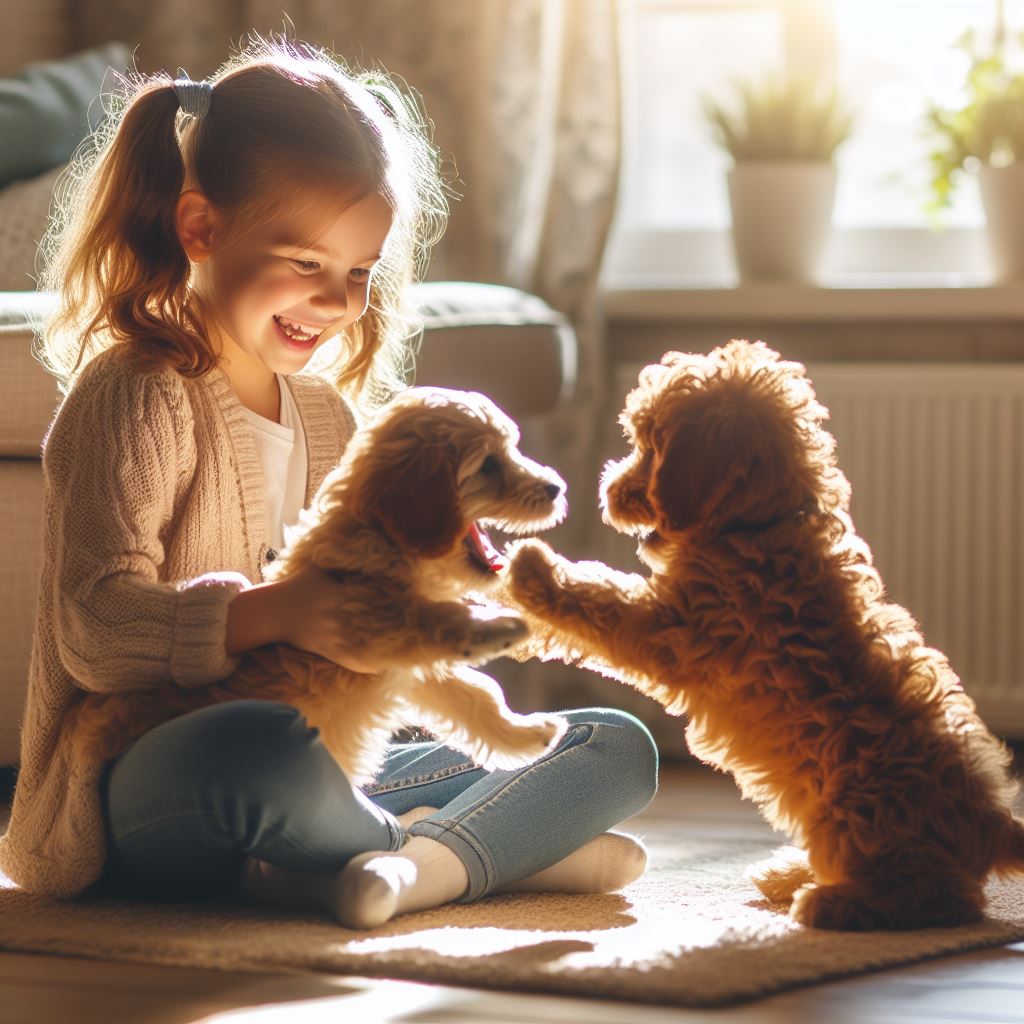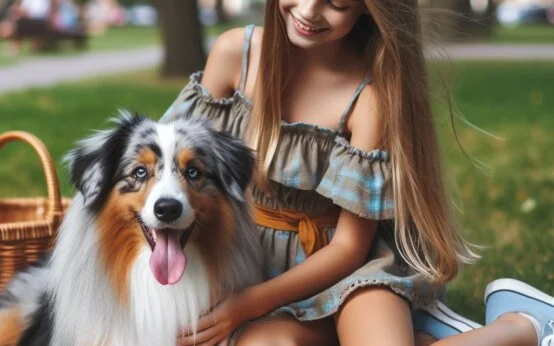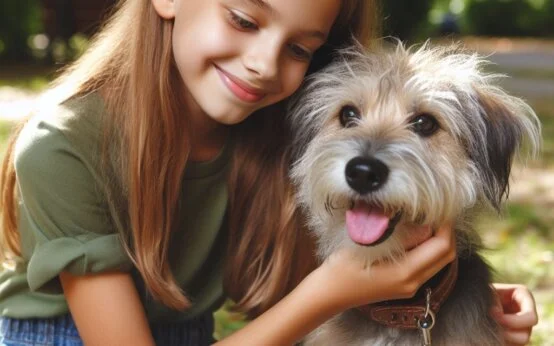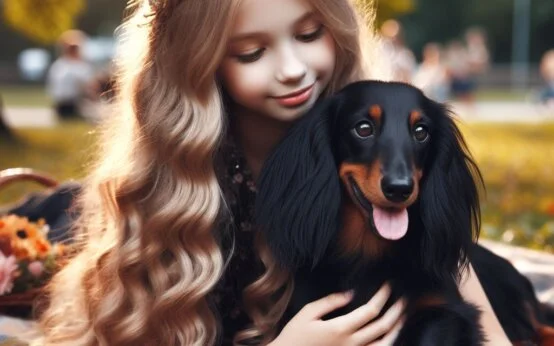A Mini Labradoodle is a crossbreed dog that is a mix between a Labrador Retriever and a Miniature Poodle. This designer breed was first developed in the 1990s with the aim of creating a hypoallergenic guide dog. Mini Labradoodles are known for their friendly and affectionate nature, making them popular as family pets.
Evolutionary Origins
The standard Labradoodle mix breed originated in Australia during the 1970s. The Royal Guide Dog Association aimed to create an allergy-friendly service dog by combining the Lab’s popular personality with the Poodle’s hypoallergenic coat. Over time, smaller versions of Labradoodles were developed, including the Mini Labradoodle.
Physical Appearance
- Size: Mini Labradoodles are small dogs, weighing between 15 to 25 pounds.
- Height: They stand at approximately 13 to 15 inches tall at the shoulder.
- Coat Types:
- Wool: Similar texture to that of a Poodle, requiring regular grooming.
- Fleece: Soft texture with either a wavy or spiral curl.
- Hair: Closer to the Labrador Retriever.
Reproduction
Mini Labradoodles are a crossbreed of Labrador Retrievers and Miniature or Toy Poodles. First-generation mixes may vary in size due to inheriting genes from both parents. Second-generation mixes are more predictable in terms of size.
Types by Breeds
- Mini Labradoodle: Combines Labrador Retriever and Miniature/Toy Poodle.
- Mini Australian Labradoodle: Includes American Cocker Spaniel, English Cocker Spaniel, and Irish Water Spaniel lineage.

Mini Labradoodle are playing with girl
Games
Mini Labradoodles thrive on interaction and play. They enjoy games, whether indoors or at the dog park. Regular exercise keeps them content and calm.
Health and Caring

Mini Labradoodle are taking caring
- Lifespan: Mini Labradoodles typically live around 12 to 15 years.
- Health Considerations: Regular vet check-ups, vaccinations, and preventive care are essential.
- Temperament: Friendly, outgoing, and eager to please.
Caretaker

Mini Labradoodle are with Caretaker
Mini Labradoodles thrive in homes where someone is around to spend time with them. They love companionship and interaction.
Dog Food
- Nutrition: High-quality dog food suitable for their size and activity level.
- Portion Control: Adjust feeding portions based on age and weight.
Socialization
Expose Mini Labradoodles to various environments, people, and other dogs. Early socialization is crucial.
Read More: The Importance of Dog socialization
Senior Dog Care and Considerations
As they age, provide comfort, joint support, and regular health check-ups.
Price
Mini Labradoodle prices vary based on lineage, breeder reputation, and location.
Relationship Between Human and Dog
- Mini Labradoodles form strong bonds with their owners.
- They thrive on love, attention, and positive interactions.
Responsible Dog Ownership
- Regular exercise, proper nutrition, and grooming.
- Comply with local regulations and be a responsible pet owner.
Dogs as Therapy and Assistance Animals
Mini Labradoodles’ friendly nature makes them excellent therapy and emotional support dogs.
Cultural Significance of Dogs in Different Societies
Dogs hold special places in various cultures worldwide, symbolizing loyalty, companionship, and protection.
Emotional Benefits of Owning a Dog
- Reduced stress and anxiety.
- Unconditional love and companionship.

Mini Labradoodle are eating Food
Physical Characteristics
Mini Labradoodles typically have a medium-sized build and can weigh between 15 to 30 pounds. They have a soft and curly or wavy coat that can come in a variety of colors, including cream, chocolate, black, apricot, and silver. Their eyes are usually round and expressive, and their ears are floppy.
One of the reasons why Mini Labradoodles are so popular is their hypoallergenic coat. While no dog is completely hypoallergenic, Mini Labradoodles have a low-shedding coat that produces less dander, making them more suitable for people with allergies.
Helpful YouTube Link: Labradoodle 101 | 10 Personalities of a Mini Labradoodle – YouTube
Temperament and Personality
Mini Labradoodles are known for their friendly and sociable nature. They are intelligent and eager to please, which makes them easy to train. They are also great with children and other pets, making them an excellent choice for families.
These dogs have a playful and energetic personality, but they are also capable of being calm and relaxed. They enjoy being part of the family and thrive on human companionship. Mini Labradoodles are typically not aggressive and get along well with strangers, making them poor guard dogs.
Exercise and Training
Mini Labradoodles are an active breed that requires regular exercise to keep them happy and healthy. Daily walks, playtime, and mental stimulation are important to prevent boredom and destructive behavior. They also enjoy activities such as swimming, hiking, and playing fetch.
Training a Mini Labradoodle is usually a straightforward process as they are intelligent and eager to please. Positive reinforcement methods, such as treats and praise, work well with this breed. Early socialization and obedience training are essential to ensure they grow into well-behaved adult dogs.
Grooming

Mini Labradoodle are taking Grooming
Grooming requirements for Mini Labradoodles can vary depending on their coat type. If they have a curly or wavy coat, regular brushing is necessary to prevent matting and tangling. They may also require professional grooming every few months to maintain their coat’s appearance.
Regular grooming also includes dental care, nail trimming, and ear cleaning. It is important to start grooming routines from a young age to get your Mini Labradoodle used to the process and make it an enjoyable experience for both of you.
Read More: The Art of Dog Grooming
Health
Like any other breed, Mini Labradoodles are prone to certain health issues. Some common health problems that can occur in this breed include hip dysplasia, eye disorders, and allergies. Regular veterinary check-ups, a balanced diet, and proper exercise can help maintain their overall health and well-being.
It is important to choose a reputable breeder who conducts health tests on their breeding dogs to minimize the risk of inherited health conditions. Responsible breeders will provide you with health clearances for both the Labrador Retriever and Miniature Poodle parents.
Read More: Common Health Issues in Dogs
Conclusion
Mini Labradoodles are a popular choice for families looking for a friendly, sociable, and hypoallergenic dog. With their adorable appearance and affectionate nature, they make excellent companions and are well-suited to both individuals and families.
Remember, owning a Mini Labradoodle is a long-term commitment, and they require proper care, training, and socialization to thrive. If you are considering adding a Mini Labradoodle to your family, do your research, find a reputable breeder, and be prepared to provide them with the love and attention they deserve.
Frequently asked questions (FAQs)
How Do Mini Labradoodles Compare to Australian Labradoodles?
There are two types of Miniature Labradoodles: Mini Labradoodle: Combines Labrador Retriever and Miniature/Toy Poodle.
Mini Australian Labradoodle: Includes American Cocker Spaniel, English Cocker Spaniel, and Irish Water Spaniel lineage.
First-generation Mini Labradoodles may vary in size due to inheriting genes from both parents. Second-generation mixes are more predictable in terms of size.
Where Do Mini Labradoodles Come From?
The standard Labradoodle mix breed originated in Australia during the 1970s. The Royal Guide Dog Association aimed to create an allergy-friendly service dog by combining the Lab’s popular personality with the Poodle’s hypoallergenic coat.
Over time, smaller versions of Labradoodles were developed, including the Mini Labradoodle, which combines Labrador Retriever and Miniature/Toy Poodle genes.
What Does Their Coat Look Like?
The Mini Labradoodle coat can be categorized into three types: Wool: Similar to a Poodle’s coat, requiring regular grooming.
Fleece: Soft texture with wavy or spiral curls.
Hair: Closer to the Labrador Retriever.
What Are the Cons of Owning a Mini Labradoodle?
Excessive Barking: Some Mini Labradoodles may bark more than desired.
Potential Health Issues: Like hip dysplasia, which can affect their quality of life.
What are the Pros of Owning a Mini Labradoodle?
Hypoallergenic: Their low-shedding coat makes them suitable for people with allergies.
Family-Friendly: Gentle, caring, and loyal, they make perfect family pets.
Easy-to-Train: Highly intelligent and eager to please.
Adaptable: Their small size suits various living situations.
Excellent Therapy Dogs: Compassionate and great for therapy work.
Low-Maintenance Grooming: Requires less grooming than some other breeds.
What is a Mini Labradoodle?
The Mini Labradoodle is a delightful hybrid dog resulting from the crossbreeding of a Labrador Retriever and a Miniature or Toy Poodle. These small-sized pups are known for their friendly nature, intelligence, and low-shedding coats.
Scientific Classification: Classified as a designer mixed breed, the Mini Labradoodle doesn’t have an established pedigree like its parent breeds. It measures around 14-16 inches when fully grown.


 Dapple Dachshund: A Unique and Lively Breed
Dapple Dachshund: A Unique and Lively Breed  Pocket Pitbull: A Compact Canine Companion
Pocket Pitbull: A Compact Canine Companion  Preparing for an Adventure: A Golden Retriever Packs Its Suitcase
Preparing for an Adventure: A Golden Retriever Packs Its Suitcase  The Blue Merle Australian Shepherd: A Captivating and Unique Breed
The Blue Merle Australian Shepherd: A Captivating and Unique Breed  Terrier Mix: A Versatile and Energetic Canine Companion
Terrier Mix: A Versatile and Energetic Canine Companion  Long Haired Dachshund: A Guide to This Charming Breed
Long Haired Dachshund: A Guide to This Charming Breed  Dapple Dachshund: A Unique and Lively Breed
Dapple Dachshund: A Unique and Lively Breed  Pocket Pitbull: A Compact Canine Companion
Pocket Pitbull: A Compact Canine Companion  Preparing for an Adventure: A Golden Retriever Packs Its Suitcase
Preparing for an Adventure: A Golden Retriever Packs Its Suitcase  The Blue Merle Australian Shepherd: A Captivating and Unique Breed
The Blue Merle Australian Shepherd: A Captivating and Unique Breed  Long Haired Dachshund: A Guide to This Charming Breed
Long Haired Dachshund: A Guide to This Charming Breed  Cane Corso: A Noble Guardian with Roman Roots
Cane Corso: A Noble Guardian with Roman Roots